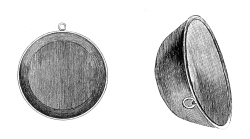Bristolian seed cake
This is really a kind of hybrid, a sweet bread baked in a loaf pan. Try not to be deterred by the use of caraway. As Mrs. Grigson wrote in 1984,
“When exactly the caraway part dropped out of favour, I am not sure…. It seems odd to me that our tastes should have changed so completely in this matter over the last eighty years, though not in Germany or Austria where the popularity of caraway seed remains high. Here, in an effort to re-establish seed cake, is a recipe that our visitors always appear to enjoy.”
Ours do too.
 -3 ½ oz self-raising flour
-3 ½ oz self-raising flour
-1 heaped teaspoon baking powder
-½ oz ground almonds
-4 oz sugar
-4 oz butter at room temperature and cut into small cubes
-2 eggs
-1 Tablespoon caraway seeds
-3 Tablespoons dark rum
Preheat the oven to 350°
- Grease a 4½ x 9 inch bread pan (preferably nonstick) or something similar with unsalted butter.
- Mix everything together with a Kitchenaid countertop mixer using the paddle or with a handheld electric eggbeater. Bake for about 50 minutes, or until a toothpick just comes clean from the center.
Notes: Despite Mrs. Grigson’s observation, which we have no reason or inclination to doubt, that seed cake had become scarce in Britain by the advent of the First World War, Orwell for one was familiar with it. In an unpublished manuscript commissioned by the British Council in 1946, he describes “a much plainer kind” of cake, “which is always better when homemade… flavoured with caraway seeds.”
- We like to blunt the spikey caraway by bashing it for a while with a mortar and pestle.
- Mrs. Grigson allows between one and two teaspoons of caraway; use more if you like.
- She also calls for between two and three tablespoons of rum, but by no means scrimp on that. Do not substitute brandy.
This is the old one.
- There is, of course, Harvey’s Bristol Cream to sip with your seed cake but we find it a pinch to the sweet side. Try substituting an Oloroso.
- For those who cannot get past the notion of caraway in their dessert, the seed cake is less traditional but equally good if you substitute a teaspoon of cinnamon for the caraway; you just cannot call it seed cake in the event.
- The witty Agnes Jekyll ground the caraway to powder for her tea bread, a good idea that diffuses the flavor and unifies the texture of the loaf. Here is her characteristically brisk recipe:
“Three teacups of flour, 2 teaspoonfuls baking powder, 1 teacup castor sugar, 1 large dessertspoonful ground caraway seeds, 1 egg, 3 oz. butter, 1 teacupful of boiling milk. Mix flour, baking powder, and sugar, rub in butter, mix the milk warmed with the egg beaten and the ground caraway seeds. Knead into a flattish brick shaped loaf or cake, and bake 20 minutes in a quick oven. To be eaten fresh, with a little butter.” (Agnes Jekyll, “Tea-Time and Some Cakes,” Kitchen Essays, London 1922, 90)
- In this context, a ‘quick oven’ should translate into 350°.
- Theodora FitzGibbon associates another recipe, more a true cake than the loaf of seed cake, with Bristol. It is called Madeira cake, but only because it should be accompanied by a glass of Madeira; the cake is flavored with lemon zest and includes no wine. It uses more butter and sugar than the seed cake and is considerably richer. You will need a seven-inch springmold. This is the cake:
-¾ cup unsalted butter
-zest of a smallish lemon
-1 cup sugar
-2 ½ cups sifted self-raising flour
-4 beaten eggs
-¼ cup milk
Beat the butter and zest until “light and fluffy, then fold in the sugar and cream again very well.” Add a quarter of the flour with each egg, beating the batter thoroughly after each addition, then pour on the milk and beat it yet again. Grease the springmold (preferably nonstick) with unsalted butter, dust the butter with a little flour and pour the batter into the mold. Bake the cake at 345° for about an hour (but check on it after 45-50 minutes) or until a toothpick just draws clean from the center. Mrs. FitzGibbon decorates the cake with a strip of candied lemon peel added during the last 15 minutes of baking. From A Taste of the West Country (London 1972).

